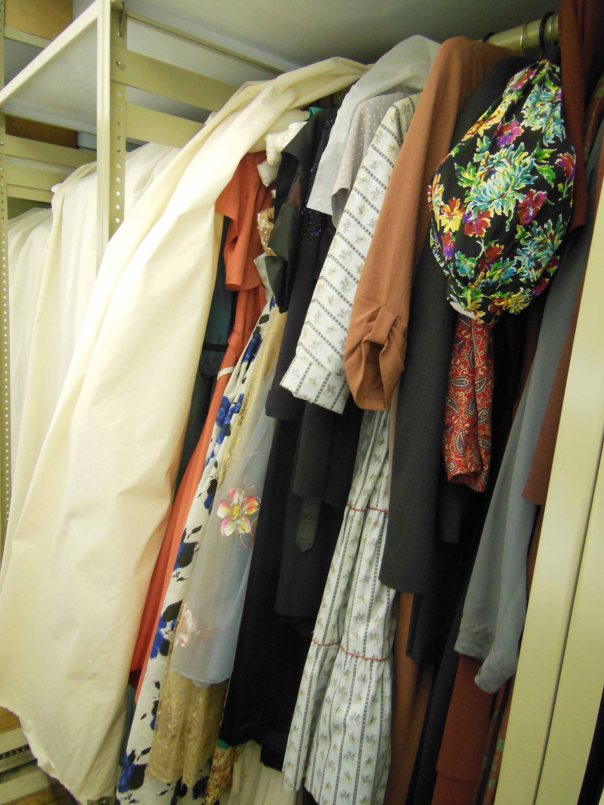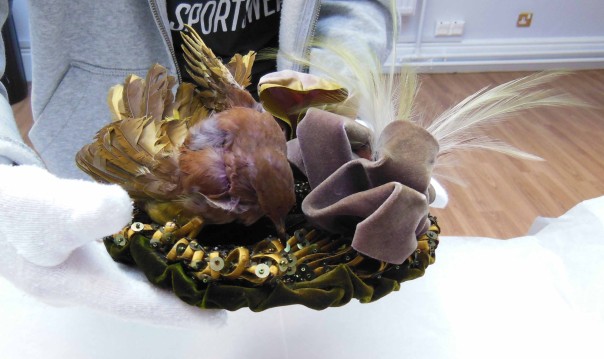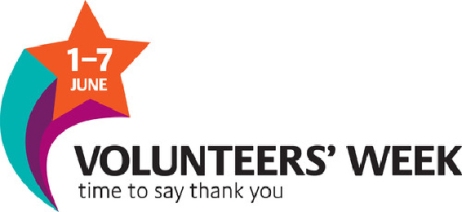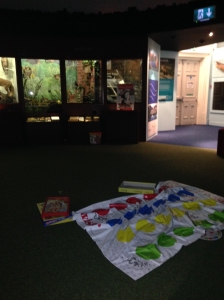Author Archives: claires
Welcome to the Cabinet of Curiosity
 Our new ‘Cabinet of Curiosity’ display in the Victorian Entrance of the museum has been designed to give everyone a glimpse of how varied Tullie House’s collections are. And to show you the types of material you can expect to find in the museum if you want to come in and take a closer look.
Our new ‘Cabinet of Curiosity’ display in the Victorian Entrance of the museum has been designed to give everyone a glimpse of how varied Tullie House’s collections are. And to show you the types of material you can expect to find in the museum if you want to come in and take a closer look.

European Cabinet of Curiosities from around 1690
We’ve been inspired by ‘Cabinets of Curiosities’, one of the first types of museums that date back to the fourteenth century. These cabinets started as display cases in private homes where well-travelled people could display all the weird and wonderful objects they had collected and show them (or show off?!) to their guests. The concept developed over the next three hundred years and expanded from a display case to creating whole rooms of objects that had the effect of inspiring wonder and stimulating creative thought.
A number of contemporary historians have gone a little further in their interpretation of these ‘Cabinets of Curiosities’. These cabinets were created during the Renaissance, a time when scholars wanted to understand how mankind fit within the grand scheme of nature and the divine. It is argued that these collections of objects were a physical manifestation of this scholarly endeavour, formed around a belief that all things were linked by visible or invisible similarities. Some people who created their own cabinet believed that by recognising the similarities between objects, they would be brought to an understanding of how the world functioned, and what mankind’s place was in it.
Both ideas are plausible: showing off, something more intellectual or indeed somewhere in between. Whatever we believe, many have argued that from these cabinets the modern museum was born out of this seemingly basic human impulse to collect and be curious about the world around us.

Winter camouflage, keeping warm and having fun in Winter
In our ‘Cabinet of Curiosity’(as you can see from the image above) the curatorial team have selected items from the collections around the theme of ‘Winter’. These quite different objects have been placed together within the case creating some intriguing contrasts that is certainly in keeping with the concepts of the ‘Cabinet of Curiosities’. Below are two objects that you can see up close in the case.

Government information pamphlet from the 1960s

Winter; Skating by Unknown Dutch artist, 1700s
This is new project for Tullie House and one that we hope to develop further, so we’d like your thoughts about what you’ve seen and how you think it can develop. Over the next few weeks we will Tweet regularly highlighting individual objects from the case, all object images will be on Pinterest and we will post another Blog featuring more in-depth information about individual objects and report on feedback we’ve received.

We’re looking forward to hearing what you have to say so Tweet or leave your comment below.
Volunteers – Caldew School NCS Students Get Involved
On Saturday 28 November, the volunteer programme were delighted to welcome 22 pupils from Caldew School to complete a day of ‘Social Action’ at Tullie House as the culmination of their National Citizen Scheme Award.
Nicky and John tell us about their day at Tullie and the work towards their award.
Last Saturday we completed our social action project at Tullie House Museum. As a group we developed and participated in three activities. The focus of the day was thinking about visitors from the community with visual impairment. This meant that one group created a sensory space in the garden, and another group researched and wrote scripts then recorded audio ‘labels’ for the Social History gallery. Finally the third and smallest group produced an NCS display, highlighting what the NCS programme involves and has to offer all young people.


To give you some background, the NCS stands the National Citizen Service award and is open for all 16-17 year olds across England and Wales. It is a journey through a series of phases with its ethos being based on:
- Challenge
- Responsibility
- Inspiration
- Social mix
- Independency
- Social action
All of us who complete the NCS journey are awarded with a certificate signed by David Cameron (prime minister). However the skills and knowledge that we gain on the route are extremely valuable to wherever our futures lead.
We are all year 12 pupils from Caldew School. The start of the course saw us go to Lockerbie Manor, an outdoor pursuits centre where we did a range of activities designed to build up our confidence and communication skills. Then over the Autumn half term we visited various places within Carlisle and improved our understanding of the local community. We also took inspiration from the local organisations which eventually led us to taking part in a social action project at Tullie House Museum.
Davie, one of the students summed their wish to participate perfectly saying “I’m here to give something back to the community” a sentiment echoed by all the students.
John Sander the NCS Co-ordinator from Carlisle United had these further comments to make:
“I am thrilled that the group have chosen to work in partnership with the city’s leading tourist attraction. The confidence and inspiration they will gain as this project develops will not only have a big effect on their futures but it will be something that they will always remember. Hopefully their endeavours both in raising the funding and then working at the museum will also have a long, lasting and beneficial effect on the city and people of Carlisle”
John Sander added:
“For most of these sixth formers who attend Caldew School the NCS journey has been a life changing experience. This relatively new government initiative has improved their employability and allowed the young people to build friendships and memories on both the away and home residential experiences that will last for ever. The work at Tullie House is now the icing on the cake that allows all these students to graduate”
What Nicky and John didn’t mention in their text above is that they also carried out fundraising that meant Tullie House was able to benefit from £200 worth of plants for the garden and further £600 for the museum. It is my intention to see these funds used to continue the work you have started.
I was very pleased to host these students and enable them to complete their award. In addition, they have made a real contribution to their museum and created superb resources for visitors to enjoy for years to come. It was a privilege for me work with these students who gave up their Saturday and worked solidly throughout the day to achieve their aims – even in the rain! Well done and thank you all!.
Claire – Volunteer Co-ordinator
Volunteers – Exhibitions Summer Placement
After many registrations were received to be the Summer Exhibitions Placement volunteer, we were delighted that Vanessa decided to join us. Here are her reflections on her completed placement.
In August I moved back to Carlisle after recently graduating with a degree in History of Art. Keen to get some hands-on experience within a museum/art gallery environment, I applied for the Summer Placement internship advertised on the Tullie House website. Meeting with Amy, the Exhibitions Programming Manager, I was happy to learn that the placement was very flexible; it could fit around my other commitments and could even be suited to my own particular interests (being the art and costume departments in particular.) The placement began a few weeks later and took place over two days- one would be focused on costume research with the exhibitions team, and the other day would be spent carrying out the costume audit alongside a team of volunteers.
The costume research was mostly computer-based and enabled me to utilise the skills I gained during my degree in a practical way. It involved studying the phases and major developments in fashion over the past two hundred years, and then cross-referencing these with the items in the museum’s costume collection in order to create a shortlist of clothes, shoes and accessories that best demonstrated these developments for an upcoming exhibition.
I was able to work independently and continuously on the same project so I was able to really get stuck-in, meeting regularly with Amy and the exhibitions team to ensure that I was on the right track.
The costume audit, on the other hand, has exposed me to an entirely new set of skills that are invaluable to my CV, from handling museum items to creating new records on the internal database, not to mention getting to paw through wonderful items of clothing that at times date all the way back to the eighteenth century!
Sophie assessing the 1920s shoes
We are currently going through the costume store box by box, inspecting the contents, ensuring they are recorded properly and are packaged so that they will be preserved for years to come. This is an ongoing project and one that I have continued to be a part of, as each week I build upon my costume knowledge and gain experience in a range of everyday tasks involved working behind the scenes in an art gallery and museum.
I would certainly recommend the Summer Placement to anyone else that has graduated and is looking to gain practical experience within the arts sector, especially as Amy and her team were so accommodating in fitting me in, and there is so much scope for what you can get involved in depending on your interests.
You did an amazing job and you’re an asset to the team. Thank you for all your hard work! Claire
Volunteers – Archaeology Archives
The treasure trove store of over 7000 boxes of archaeological material has been the destination for our team of dedicated volunteers.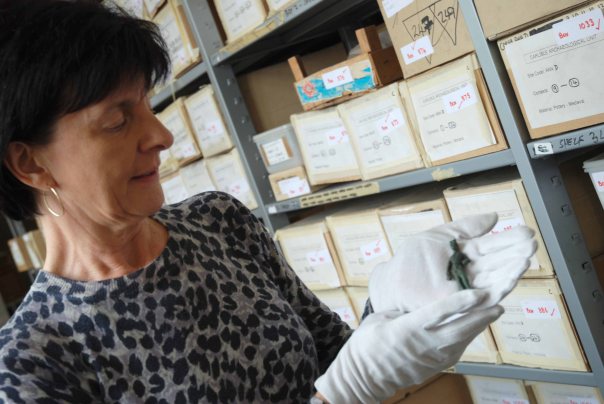
Working alongside Tim, the curator of archaeology, the team are well underway with the huge task of creating a comprehensive inventory of this diverse material.
As well as displaying objects, Tullie House also stores for future reference and research finds from many of the excavations carried out in north Cumbria. From boxes of animal bone and pottery sherds to the finest gold jewellery it all finds its way here, all providing the evidence for our unwritten past.
Managing this volume of material is a big job and one that one archaeology curator cannot carry out alone, so this is why we are so grateful to the hardy team of volunteers who give up their time to assist with this task. It could not be done without them.
I went down the store to meet up with the team to see their progress, and they showed me some of their favourite finds so far.
This “amazing find!”… “It’s so complete and readily identifiable as Mercury”.
This coin is great condition, as you can see from its packaging it was found during the excavation of Annetwell Street during the redevelopment of Tullie House.
An almost complete Roman iron lamp from the Millennium excavations, again close to Tullie House. Found from the area where the steps from the underpass come up in front of Carlisle Castle.
And Tim, with a relatively modern (19th century?) teaspoon proving that it doesn’t have to be 1000s of years old to be significant to archaeologists!.
Thank you Pam, Diana, Kath, Siriol, Chloe and Sally for all your hard work on this collection!
Get involved
 If you’ve been inspired and would like to get involved or find out more please visit our website. I look forward to hearing from you.
If you’ve been inspired and would like to get involved or find out more please visit our website. I look forward to hearing from you.
Claire, Volunteer Co-ordinator
Volunteers – A great big thank you!
As we’re in the middle of national volunteer week, we thought it was a great opportunity to celebrate and offer a very warm and heartfelt thank you to the 59 volunteers who have contributed to Tullie House over the last year.
Your support over the last 12 months has made a real difference to the 250,000 visitors who enjoy and learn from your museum.
Tullie House has volunteers?
Many don’t realise that Tullie House is a charity, and along with most other charities it welcomes the support of volunteers. There are a number of services that we could not offer if people were not prepared to give up their time. Volunteers form an integral part of our team and work and show us that successful volunteering isn’t just about getting a job done but it’s about local people getting involved with their museum and supporting their community.
How do volunteers help?
 Over the past 12 months volunteers have supported the museum in so many ways. In the early part of the year 12 volunteers met with our visitors to carry out surveys to find out about their time in the museum. The information gathered is being used by us to make sure we’re providing the services people want.
Over the past 12 months volunteers have supported the museum in so many ways. In the early part of the year 12 volunteers met with our visitors to carry out surveys to find out about their time in the museum. The information gathered is being used by us to make sure we’re providing the services people want.
 Towards the end of the year, we started a new project to inventory over 8000 boxes of archaeological material. Through their work our team of seven volunteers are helping us plan for future collection needs and find the next treasures to go on display.
Towards the end of the year, we started a new project to inventory over 8000 boxes of archaeological material. Through their work our team of seven volunteers are helping us plan for future collection needs and find the next treasures to go on display.
 We also have many long-serving volunteers who give their time tirelessly to keep our gardens lovely for all to enjoy and our longest serving volunteer who has contributed regularly for over 25 years to catalogue our collections.
We also have many long-serving volunteers who give their time tirelessly to keep our gardens lovely for all to enjoy and our longest serving volunteer who has contributed regularly for over 25 years to catalogue our collections.
In addition, there are volunteers who help deliver activity sessions for visitors in the museum, and those behind the scenes at the Cumbria Biodiversity Diversity Centre. In my new quarterly blog posts I’ll introduce you to the volunteers we have at Tullie House and the difference they make to our museum and the communities we serve.
Get involved
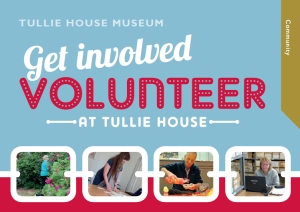 Volunteering is a way of joining in and making a difference. It’s also a great way for volunteers to develop and share skills. So if you’ve been inspired and would like to get involved or find out more please visit our website.
Volunteering is a way of joining in and making a difference. It’s also a great way for volunteers to develop and share skills. So if you’ve been inspired and would like to get involved or find out more please visit our website.
To all our current and previous volunteers: thanks for all that you do, whether it’s out in the garden on a rainy Tuesday, creating inventories of our thousands of boxes of archaeological collections or meeting visitors to find out about their time in the museum; we wouldn’t want to do it without you.
Claire, Volunteer Co-ordinator
THe Shed – More Life, Laws and Legacies
THe Shed in Tullie House may now be closed but there’s still chance experience the Tudor themes from the last exhibition. Our original Tudor building the ‘Guildhall’ is open for this week of the school holidays and again in May for the summer.
Eloise shares with us some information about the final Shed exhibition and the Guildhall.
The final shed exhibition, Life, Laws and Legacies has ended with the Mayor and Mayoress coming to re-open our treasured Guildhall Museum, which is the third oldest building in Carlisle after the Castle and Cathedral.
For those of you who missed seeing the City’s wonderful Dormont Book, there is a copy of the weird and wonderful old laws kept in the Guildhall, where you can see some of our treasures from Carlisle’s Tudor past.
You can see the huge iron bound Muniment chest where the City’s documents and treasure were stored, and also the world’s oldest sports trophies are housed in the Guildhall Museum.
These horse racing bells date from 1599 and older, and were given as prizes by the Tudor mayor and Lady Dacre.
Come and explore this beautiful oak beamed building, with its wattle and daub walls, and feel like you can step back in time. The men who signed the Dormont Book sat in these very rooms nearly 450 years ago.
Isaac Tully, whose family built Tullie House was a member of the merchants guild here. He still owes the Guild 40 shillings fine for allowing his sister to work in his shop!
So overall, are we really just terribly Modern Tudors? Well, yes, I think we might be!
THe Shed – Last week to see it!
This may be the last week of THe Shed but we’re not winding down yet.
This last Monday we held a celebration party to thank everyone who helped make the 16 different projects unique and worthwhile. I’m still totting up the final numbers, but so far there have been over 200 people who have directly participated with several thousand who have come to see the exhibitions. Once all the data is in I will blog about this some more.
All of the people who were involved – and we had a contact for – were invited to come along and help us enjoy some yummy food and get into the party spirit in a special evening opening of the galleries.
We had a lovely comment on Facebook after the party, with Sarah, one of the contributors to Making a Festive Exhibition of Yourself saying
“Just wanted to say thank you very much for having us all this evening. The food was gorgeous and it was so nice being able to show Harry’s Daddy around the museum as well.”
If you have taken part and want to tell us about your experience then I’d love to hear from you #THShed or message us on Facebook or leave your comment below.
There is still time to come and see what you have been missing. Life, Laws and Legacies with Carlisle’s original Tudor Dormont book is still on show alongside some review panels of some of our past projects alongside our fabulous museum collection objects in What’s in Store.
Make this last chance count!
Claire
THe Shed – Terribly Modern Tudors
The newest exhibition Life, Laws and Legacies: Tudor Carlisle in Modern Perspective is up and running. And we can brag about another first for THe Shed – this being the first time Carlisle’s Dormont Book (the original handwritten document that lists all of Carlisle’s bylaws) has been on show in Tullie House. Project leader and guest blogger Eloise introduces the show
We’re now into March, and the final project has just gone up in The Shed! Come and explore Carlisle’s Tudor past through the Dormont Book, written in 1561, and help contribute to the exhibition with your own stories of life in Carlisle.
It’s been a crazy few weeks getting the last of the materials together, from re-designing the information panels, to cutting up loads of tiny Tudor pointing hands! Thanks to Jill, Cathy, Ian and Cassie, we’re installed and ready for visitors!
Working with the Dormont Book has been a fascinating experience. I’ve always loved Tudor history, but reading some of the actual laws from Carlisle’s past has been a real eye-opener in learning just how much we have in common with the real people of Carlisle nearly 450 years ago.
From stopping your pigs escaping onto the street to women setting up their own businesses, the book is full of colourful examples of the laws which governed Carlisle, and the legacies of the early council and city officials who still play a part in modern society
See it in THe Shed until 29 March
THe Shed – Capturing Cumbria’s Voice
7 March to 23 March 2015
A brand new collaborative piece of work by two of Cumbria’s emerging artists is on now in THe Shed.
Steve Crook and Jenn Mattinson’s project uses photographs, sound effects and recorded interviews to create some fascinating insights into some of Cumbria’s residents. For example, who knew that horse physiotherapy was practiced? Now’s your time to find out! Jenn as guest blogger tells us about their work:
Capturing Cumbria’s Voice Social History in the making
We have been working on a project that explores the relationship between portrait photography, people’s stories and sound.
The lives of four folk from Cumbria was our focus. From a variety of social and economic backgrounds, Gordon, Ross, Dawn and Bob shared their passions, experiences, memories and personality through their willingness to be photographed and interviewed. The result is a demonstration of how seemingly ordinary people living within our region are contributing to its unique social history.
The four selected profiles, that appear as a slideshow of images and sound, have been designed to capture interest from a wide ranging audience. The people behind the profiles are very genuine, honest individuals at different points in their lives, expressing a real passion for their chosen subjects. Themes include transport enthusiasm, aspirations to become a champion boxer, horse physiotherapy and a love of music.
Steve and I have married together a collection of artistic mediums – portrait photography, oral history, spoken word, poetry and sound effects – and hope that the result will reflect the ways in which different art forms can work together and complement each other to provide a slightly more unconventional way of showcasing and displaying artistic work. This is our first artistic collaboration.
Here’s a little more about each artist:
Steve Crook’s photography belongs to a genre that combines portraiture and social documentation, inspired by the likes of Daniel Meadows, Tony Ray-Jones, Chris Killip and Larry Fink. A great deal of his work is presented in the form of photostories or collections. Recent projects include ‘Rare Breed’, a study of the members of Springfield Homing Club and ‘Jubilee, the way we were’, a series of portraits taken on the day of the Queen’s Diamond Jubilee. Steve is currently working with descendants of World War One soldiers to create a photographic link between those who fought and those they fought for.
Jenn Mattinson is a freelance Creative Practitioner, specialising in oral history, sound and media, theatre and reminiscence. She is passionate about working creatively in local communities, with young people, adults, the older generation and in an intergenerational context. Jenn is currently working with Morecambe Bay Partnership to facilitate and deliver a four year oral history project centred on the inshore fishing communities across Morecambe Bay. She is also leading a series of creative arts sessions for older people in West Cumbria and for people living with dementia at Theatre by the Lake in Keswick.
See it in the Work in Progress area of THe Shed until the 23rd.
Claire









